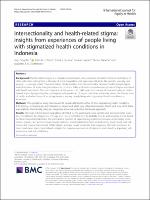| dc.description.abstract | Background:
Existing research on health equity falls short of identifying a comprehensive set of indicators for measurement across health systems. Health systems in the ASEAN region, in particular, lack a standardised framework to assess health equity. This paper proposes a comprehensive framework to measure health equity in the ASEAN region and highlights current gaps in data availability according to its indicator components.
Methods:
A comprehensive literature review was undertaken to map out a core set of indicators to evaluate health equity at the health system level. Secondary data collection was subsequently conducted to assess current data availability for ASEAN states in key global health databases, national health accounts, and policy documents.
Results:
A robust framework to measure health equity was developed comprising 195 indicators across Health System Inputs and Processes, Outputs, Outcomes, and Contextual Factors. Total indicator data availability equated to 72.9% (1423/1950). Across the ASEAN region, the Inputs and Processes sub-component of Health Financing had complete data availability for all indicators (160/160, 100%), while Access to Essential Medicine had the least data available (6/30, 20%). Under Outputs and Outcomes, Coverage of Selected Interventions (161/270, 59.63%) and Population Health (350/350, 100%) respectively had the most data available, while other indicator sub-components had little to none (≤ 38%). 72.145% (384/530) of data is available for all Contextual Factors. Out of the 10 ASEAN countries, the Philippines had the highest data availability overall at 77.44% (151/195), while Brunei Darussalam and Vietnam had the lowest data availability at 67.18% (131/195).
Conclusions:
The data availability gaps highlighted in this study underscore the need for a standardised framework to guide data collection and benchmarking of health equity in ASEAN. There is a need to prioritise regular data collection for overlooked indicator areas and in countries with low levels of data availability. The application of this indicator framework and resulting data availability analysis could be conducted beyond ASEAN to enable cross-regional benchmarking of health equity. | |




